Teacher Guide: Book Clubs
One of the most exciting moments in a young reader’s life is when they finally “graduate” to reading chapter books!
As a teacher you know, that helping readers make the transition from picture to chapter books means teaching students to sustain comprehension across longer texts. With the BookPagez Book Club Resource Sets, you have everything you need to help students comprehend and enjoy chapter books.
As a teacher you know, that helping readers make the transition from picture to chapter books means teaching students to sustain comprehension across longer texts. With the BookPagez Book Club Resource Sets, you have everything you need to help students comprehend and enjoy chapter books.
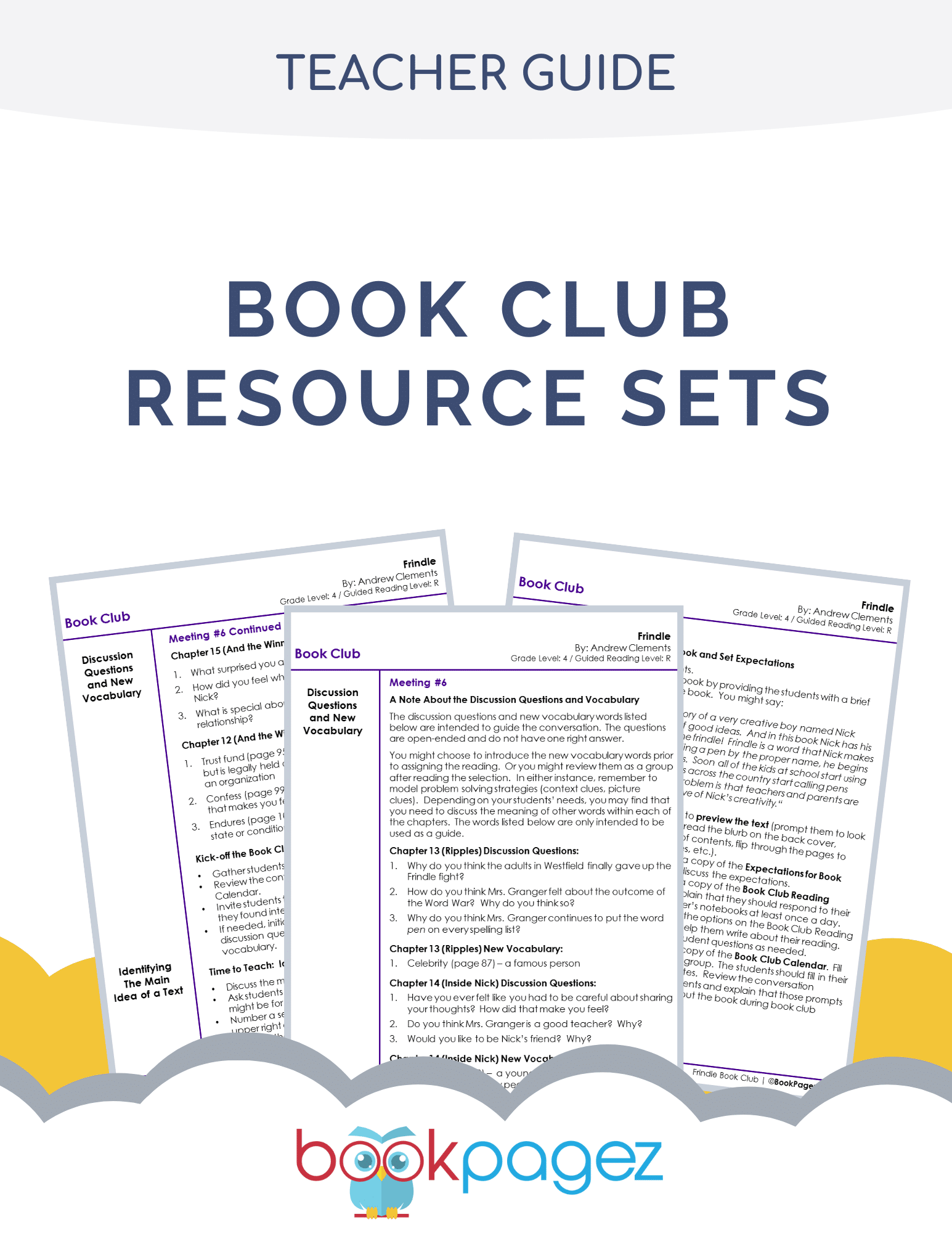
Table Of Contents
Overview of the Book Club Resources
The Book Club Resource Sets use chapter books as a springboard for instruction.
Every Book Club has been thoughtfully developed to provide readers with plenty of opportunities to practice using a specific comprehension skill. Through practicing with authentic text, students learn to become strategic, expand their knowledge of genre, develop author preferences, and begin to establish themselves as reading experts.
Here's how the Book Club Resource Sets Work:
Each resource set focuses on a specific comprehension skill. Here are some examples of the skills:
Each resource set includes the following:
You'll find that each Book Club Resource Set has been carefully designed to encourage deeper comprehension through the use of literature discussion groups. Each meeting provides opportunities for the students to absorb new concepts, discuss their thoughts and findings, work collaboratively with peers, and reflect on their learning and how it can be applied to their future independent reading.
Every Book Club has been thoughtfully developed to provide readers with plenty of opportunities to practice using a specific comprehension skill. Through practicing with authentic text, students learn to become strategic, expand their knowledge of genre, develop author preferences, and begin to establish themselves as reading experts.
Here's how the Book Club Resource Sets Work:
Each resource set focuses on a specific comprehension skill. Here are some examples of the skills:
- Making Inferences (e.g. drawing conclusions, citing the text)
- Determining Theme (e.g. identifying main ideas and supporting details)
- Exploring Story Elements (e.g. character development, character traits, plot development)
- Exploring Figurative Language
- Examining an Author's Use of Text Structures to Tell a Story (e.g. problem/solution, cause/effect, compare/contrast)
- Examining Points of View
- Exploring the use of Visual Elements to Tell a Story
Each resource set includes the following:
- Book Club Meetings (discussion questions, key vocabulary, mini lesson, instructional resources)
- Management Resources available in both English and Spanish (calendar, expectations for Book Club, reading response board, self assessment)
- Assessment Resources (focus assessment, CCSS aligned comprehension assessment, running record)
- Optional Activities (vocabulary development activities, culminating activity)
- Standards Alignment (CCSS and TEKS)
You'll find that each Book Club Resource Set has been carefully designed to encourage deeper comprehension through the use of literature discussion groups. Each meeting provides opportunities for the students to absorb new concepts, discuss their thoughts and findings, work collaboratively with peers, and reflect on their learning and how it can be applied to their future independent reading.
Video Walkthrough
Book Club Lesson Plans: A Step by Step Guide
Each Book Club Resource Set includes detailed mini lessons and resources for each meeting.
The number of meetings in each resource set varies based on the level and length of the book. For example, a shorter book may have 4 meetings, while a longer, more sophisticated novel may have 8 meetings.
Regardless of the number of meetings, all of the book clubs follow the same format and include a first meeting, a set of middle meetings, and a final meeting.
The first meeting has 2 objectives:
The middle meetings all follow the same format. As a result, the lesson plans indicate suggested time allowances for each stage of the meeting. Depending on your pacing and the needs of the students, you may have to adjust your scheduling.
The final meeting includes an opportunity for students to reflect on the work they did while in Book Club, to discuss any lingering questions they might have about the book, and to identify how they can use what they learned in Book Club during independent reading. This meeting also includes an optional assessment.
Each Meeting contains the following parts:
PART 1: Kick Off the Book Club
PART 2: Time to Teach
PART 3: Model How to Respond to Reading
PART 4: Take Time to Reflect
PART 5: Wrap Up the Book Club Meeting
The number of meetings in each resource set varies based on the level and length of the book. For example, a shorter book may have 4 meetings, while a longer, more sophisticated novel may have 8 meetings.
Regardless of the number of meetings, all of the book clubs follow the same format and include a first meeting, a set of middle meetings, and a final meeting.
The first meeting has 2 objectives:
- To introduce the rules and expectations involved with Book Club participation, and
- To introduce the instructional focus.
The middle meetings all follow the same format. As a result, the lesson plans indicate suggested time allowances for each stage of the meeting. Depending on your pacing and the needs of the students, you may have to adjust your scheduling.
The final meeting includes an opportunity for students to reflect on the work they did while in Book Club, to discuss any lingering questions they might have about the book, and to identify how they can use what they learned in Book Club during independent reading. This meeting also includes an optional assessment.
Each Meeting contains the following parts:
PART 1: Kick Off the Book Club
PART 2: Time to Teach
PART 3: Model How to Respond to Reading
PART 4: Take Time to Reflect
PART 5: Wrap Up the Book Club Meeting
Part 1: Kick Off the Book Club
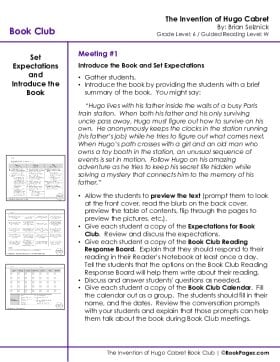
Each meeting type (first, middle, and final) has a different goal for this portion of the meeting.
The first meeting lays the foundation for a great Book Club. Spending a few extra minutes setting the expectations for student participation and building anticipation for reading the book with a great summary pays off in improved student engagement. The lesson plan provides a sample book summary and instructions for walking students through the Management Resources.
Once students are on a roll with Book Club participation, this portion of the middle and final meetings become a time to bring students together and open conversation about the book. You can choose to discuss vocabulary words, ask a discussion question, use a conversation prompt, or invite students to share something from the text that jumped out at them while they were reading independently (a part that they found interesting, funny, confusing, etc.)
The first meeting lays the foundation for a great Book Club. Spending a few extra minutes setting the expectations for student participation and building anticipation for reading the book with a great summary pays off in improved student engagement. The lesson plan provides a sample book summary and instructions for walking students through the Management Resources.
Once students are on a roll with Book Club participation, this portion of the middle and final meetings become a time to bring students together and open conversation about the book. You can choose to discuss vocabulary words, ask a discussion question, use a conversation prompt, or invite students to share something from the text that jumped out at them while they were reading independently (a part that they found interesting, funny, confusing, etc.)
Part 2: Time to Teach
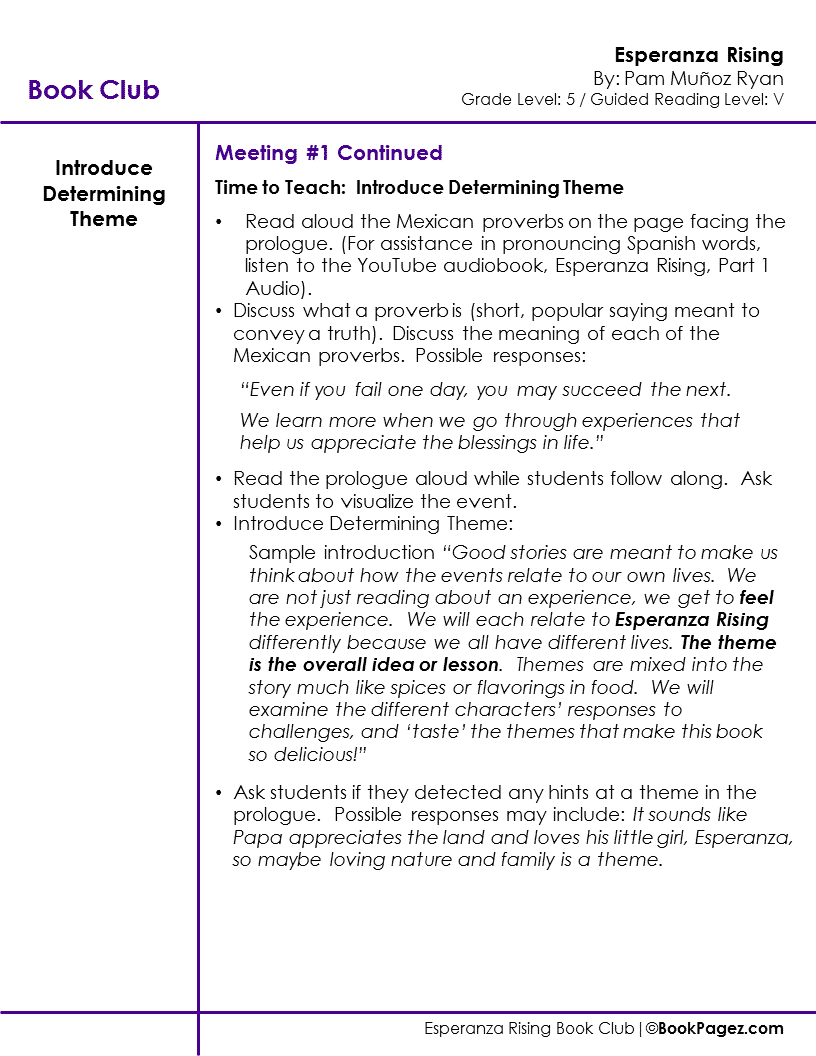
This portion of the meeting is where your direct instruction happens.
Each mini lesson connects the instructional focus with pre-selected text excerpts, making it easy for students to see the immediate applicability of the mini lesson. The connections you draw for your students are supported by anchor charts, hands-on activities, text-to-world connections, and carefully scripted language, all of which make it easy to turn your book club meetings into meaningful learning experiences for your students.
The first meeting introduces the overall instructional focus for the Book Club and sets up the logical progression of skills that will ultimately lead to the mastery of the instructional focus. Often, the instructional focus is first introduced using something taken from the student’s ”real world”. A popular children’s book, photographs, games, etc. can all be used to activate students’ thinking by making connections to what they already know.
The mini lessons presented in the middle meetings are building blocks that work to help students deeply comprehend the overall instructional focus of the Book Club. As the teacher, you are at the center of this portion of the meeting. Your job is to do the following:
This meeting also serves to do the following:
Each mini lesson connects the instructional focus with pre-selected text excerpts, making it easy for students to see the immediate applicability of the mini lesson. The connections you draw for your students are supported by anchor charts, hands-on activities, text-to-world connections, and carefully scripted language, all of which make it easy to turn your book club meetings into meaningful learning experiences for your students.
The first meeting introduces the overall instructional focus for the Book Club and sets up the logical progression of skills that will ultimately lead to the mastery of the instructional focus. Often, the instructional focus is first introduced using something taken from the student’s ”real world”. A popular children’s book, photographs, games, etc. can all be used to activate students’ thinking by making connections to what they already know.
The mini lessons presented in the middle meetings are building blocks that work to help students deeply comprehend the overall instructional focus of the Book Club. As the teacher, you are at the center of this portion of the meeting. Your job is to do the following:
- Break the big instructional focus into digestible pieces for your students
- Explicitly connect your instruction directly to the text
This meeting also serves to do the following:
- Clear any misconceptions students may have related to the text or the instructional focus
- Help students identify ways to incorporate their mastery of the instructional focus into their future reading.
Part 3: Model How to Respond to Reading
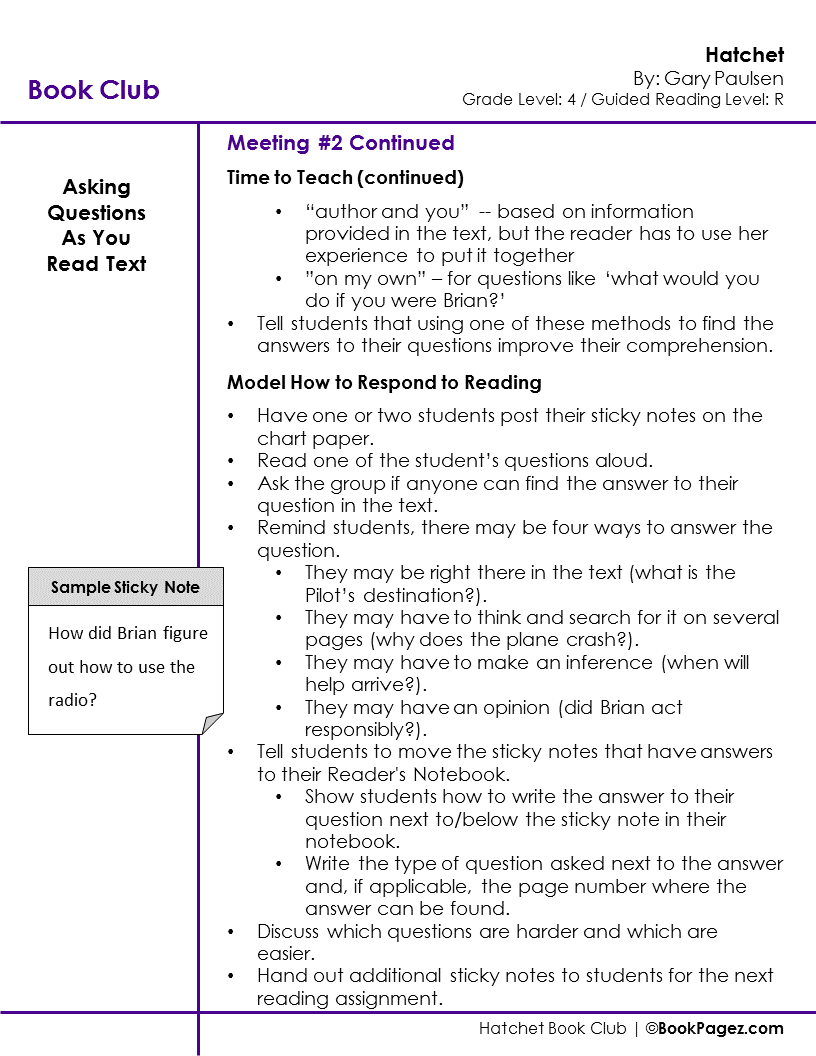
This portion of the meeting is where you’ll transfer responsibility to the students.
Now is when your students will be ready to begin practicing the concept being taught with the support of the teacher and/or a partner. As the teacher, your role evolves into more of an active participant in the discussion rather than that of an instructor. Your job is to provide support when students need it and guide the discussion to include higher-level thinking.
During this portion of the first and middle meetings, students will do the following:
Now is when your students will be ready to begin practicing the concept being taught with the support of the teacher and/or a partner. As the teacher, your role evolves into more of an active participant in the discussion rather than that of an instructor. Your job is to provide support when students need it and guide the discussion to include higher-level thinking.
During this portion of the first and middle meetings, students will do the following:
- Actively connect the focus of the meeting’s mini lesson to examples from the text
- Track their thinking related to the instructional focus using a Reader’s Notebook or some type of graphic organizer (sample answers and answer keys are included in the resource set)
Part 4: Take Time to Reflect
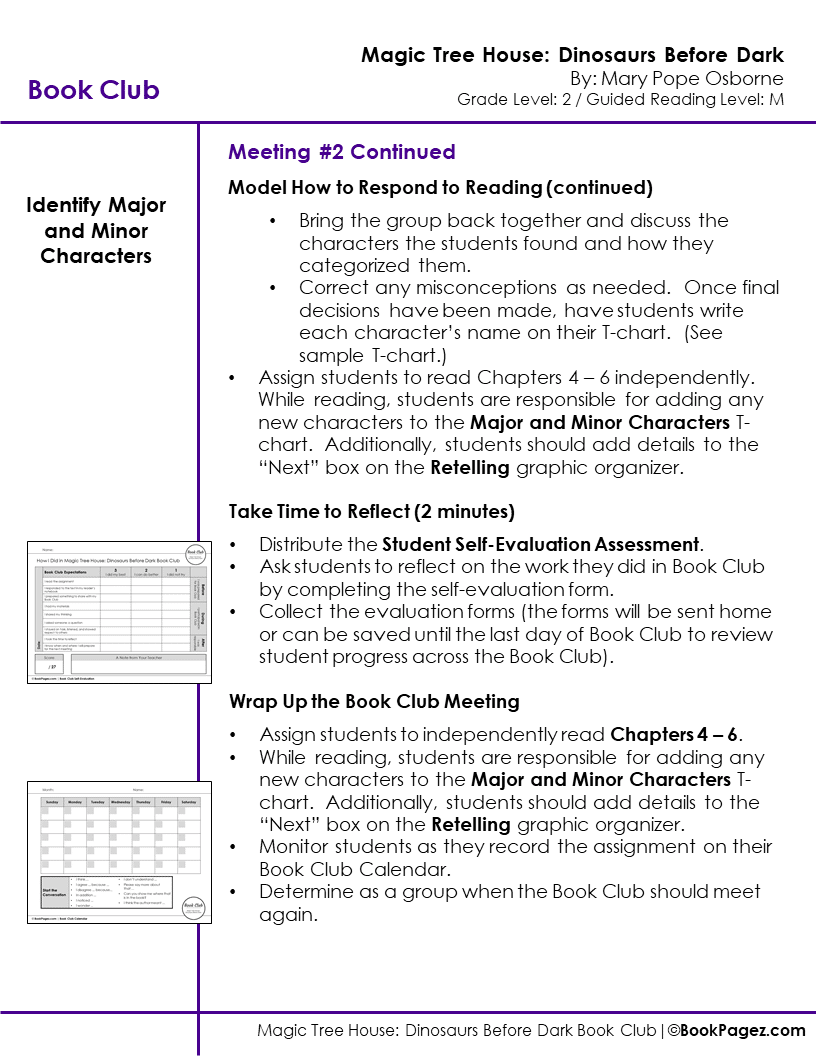
One way to support a reader’s independence and accountability is to encourage the student to reflect on his/her learning. Each of the Book Club resource sets includes opportunities for reflection during the middle and final meetings.
During the middle meetings, students are asked to spend 1-2 minutes completing a self-evaluation form. The form asks students to rate themselves on a 1-3 scale for their behavior before, during, and at the end of the Book Club meetings. You can use the self-evaluation form in a variety of ways, including:
During the middle meetings, students are asked to spend 1-2 minutes completing a self-evaluation form. The form asks students to rate themselves on a 1-3 scale for their behavior before, during, and at the end of the Book Club meetings. You can use the self-evaluation form in a variety of ways, including:
- To track student progress
- As a springboard for individual student conferences
- As an assessment tool to share with parents
- Conferring with individual students to assess comprehension, oral reading fluency, or group discussion
- If the self-evaluation forms have been collected throughout the Book Club, this is a good time to distribute and review them; noting growth and progress across the weeks
- Build your classroom reading community by discussing what students enjoyed or found challenging about participating in the literature discussion group
- Identifying sources of pride and areas to improve upon, and reflecting on takeaways from the Book Club experience that can be applied to other parts of the day
Part 5: Wrap Up the Book Club Meeting

Just as it is important to start Book Club off on the right foot, students also benefit from bringing closure to each meeting. That’s why each meeting ends by recapping responsibilities and offers students a moment to gather their thoughts before moving on to the next part of their day.
The first and middle meetings, provide students with an independent reading assignment that includes both the pages/chapters to be read and what the student is responsible for doing while he/she is reading.
The ready-to-use management resources make it easy for students to keep track of these tasks. The Book Club Calendar is a handy place for students to reference when the group will meet next and the Reading Response Board provides a wide range of prompts to help reinforce the use of comprehension strategies while the students are reading independently.
The wrap-up for the final meeting draws Book Club to a close. You may choose to meet with students individually, review assessments, set goals for future Book Club participation, and distribute any materials that were collected during the Book Club.
The first and middle meetings, provide students with an independent reading assignment that includes both the pages/chapters to be read and what the student is responsible for doing while he/she is reading.
The ready-to-use management resources make it easy for students to keep track of these tasks. The Book Club Calendar is a handy place for students to reference when the group will meet next and the Reading Response Board provides a wide range of prompts to help reinforce the use of comprehension strategies while the students are reading independently.
The wrap-up for the final meeting draws Book Club to a close. You may choose to meet with students individually, review assessments, set goals for future Book Club participation, and distribute any materials that were collected during the Book Club.
Assessment Resources
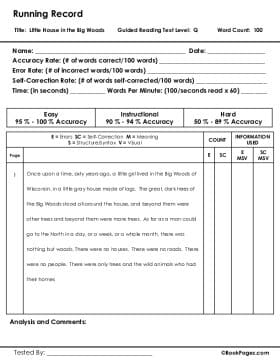
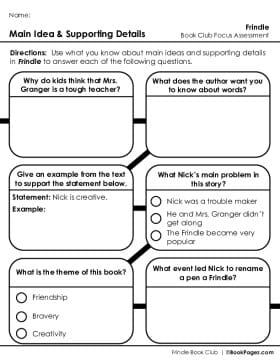
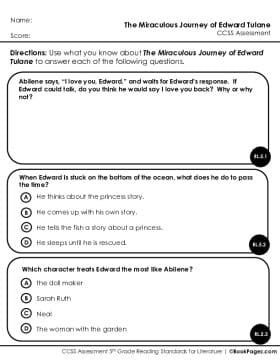
Each Book Club Resource Set includes the following assessment tools:
The Running Record can be used to assess whether or not the text is a good fit for the readers in your classroom. By evaluating each student’s oral reading fluency and miscue patterns, you will be able to identify which students are a good fit for each Book Club. To learn more about running records, click here.
FOCUS ASSESSMENT
The Focus Assessment is a combination of six short-answer and multiple-choice questions. The purpose of these questions is to determine whether or not the students understood the key concepts associated with the instructional focus of the Book Club. A scoring rubric is also included with the Focus Assessment. Based on their responses to the Focus Assessment, students are rated from beginning through secure. For students less than secure, a checklist of areas for improvement is available.
COMMON CORE ASSESSMENT
The Common Core Assessment is a combination of nine short-answer and multiple-choice questions. The purpose of these questions is to gauge students’ overall comprehension of the text and his/her mastery of the Common Core State Standards.
- Running Record
- Focus Assessment
- Common Core Assessment
The Running Record can be used to assess whether or not the text is a good fit for the readers in your classroom. By evaluating each student’s oral reading fluency and miscue patterns, you will be able to identify which students are a good fit for each Book Club. To learn more about running records, click here.
FOCUS ASSESSMENT
The Focus Assessment is a combination of six short-answer and multiple-choice questions. The purpose of these questions is to determine whether or not the students understood the key concepts associated with the instructional focus of the Book Club. A scoring rubric is also included with the Focus Assessment. Based on their responses to the Focus Assessment, students are rated from beginning through secure. For students less than secure, a checklist of areas for improvement is available.
COMMON CORE ASSESSMENT
The Common Core Assessment is a combination of nine short-answer and multiple-choice questions. The purpose of these questions is to gauge students’ overall comprehension of the text and his/her mastery of the Common Core State Standards.
Management Resources
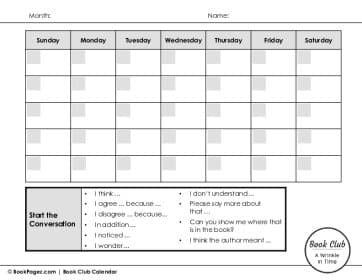
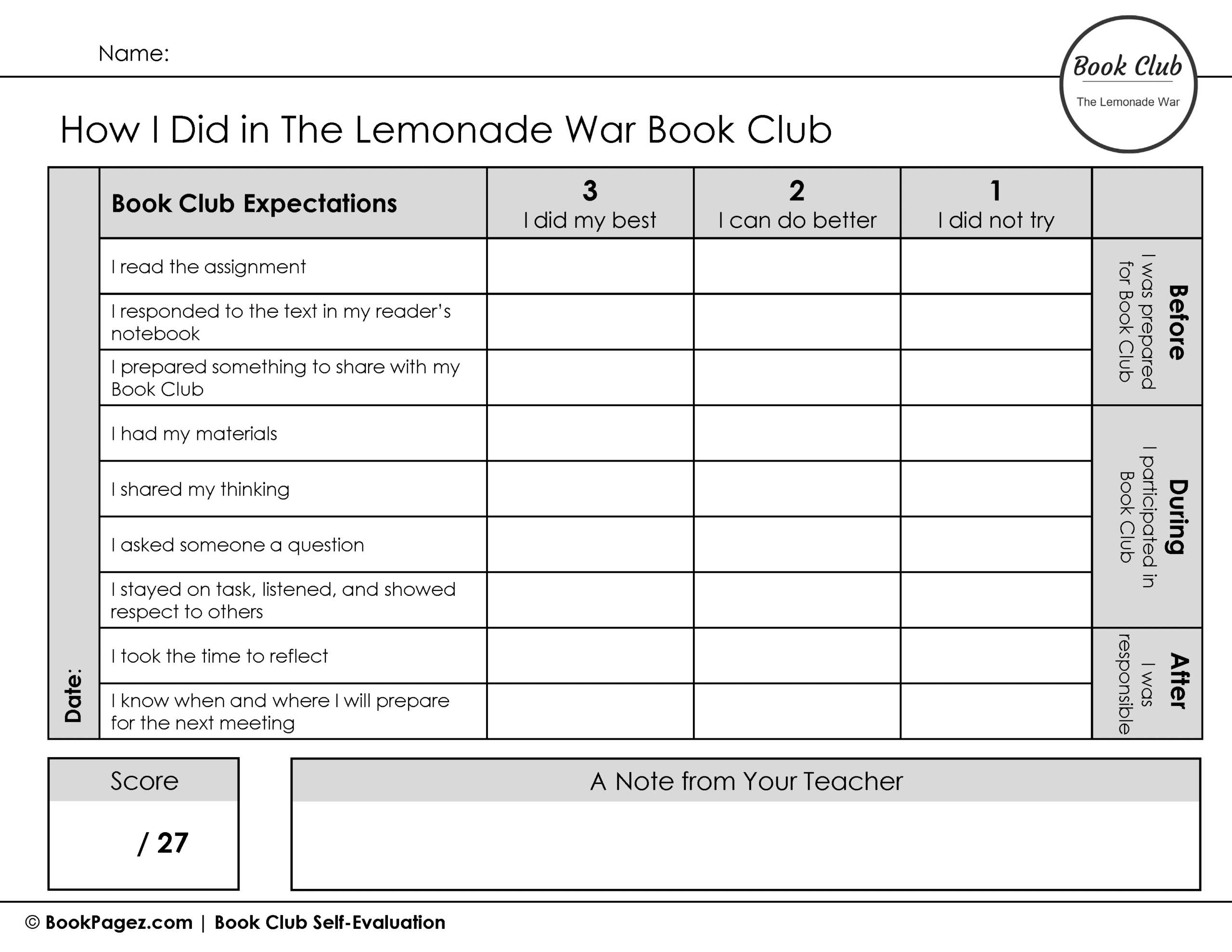
(available in Spanish)
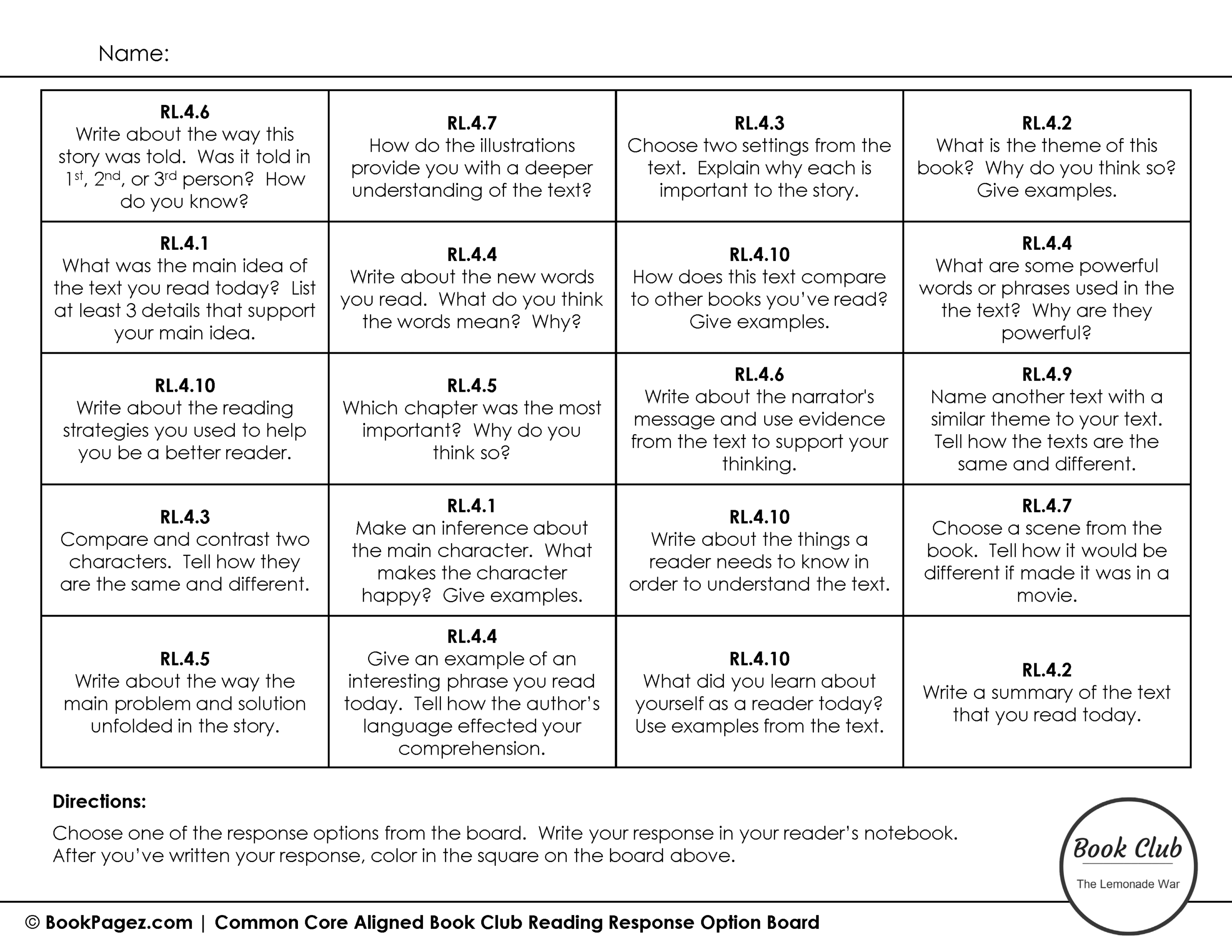
Each Book Club Resource Set includes the following management resources, all of which are available in Spanish:
Keep everyone on the same page with this calendar. Students can number the days of the month and keep track of their reading assignments. Plus, it comes with a list of conversation prompts to support reluctant students and help you avoid lulls during discussion time.
SELF ASSESSMENT
Self evaluation can be a really powerful tool for students. By making your expectations clear, students will always know what they should be doing during Book Club. This self assessment will help students reflect on the work they do before and after book club as well as the ways they contribute during the meetings.
READING RESPONSE OPTION BOARD
Option boards hold students accountable during independent reading time. They also give students ownership over the work they do as readers. Invite students to choose the option they like best and use it to respond to their reading.
Note: This option board can be printed with or without the Common Core State Standards.
- Book Club Calendar and Conversation Prompts
- Self Assessment
- Reading Response Option Board (with optional Common Core alignment)
- Expectations for Book Club Reference Sheet (not pictured)
Keep everyone on the same page with this calendar. Students can number the days of the month and keep track of their reading assignments. Plus, it comes with a list of conversation prompts to support reluctant students and help you avoid lulls during discussion time.
SELF ASSESSMENT
Self evaluation can be a really powerful tool for students. By making your expectations clear, students will always know what they should be doing during Book Club. This self assessment will help students reflect on the work they do before and after book club as well as the ways they contribute during the meetings.
READING RESPONSE OPTION BOARD
Option boards hold students accountable during independent reading time. They also give students ownership over the work they do as readers. Invite students to choose the option they like best and use it to respond to their reading.
Note: This option board can be printed with or without the Common Core State Standards.
Vocabulary Activities
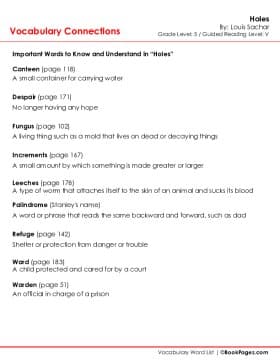
An essential part of building comprehension across longer texts is understanding new vocabulary. The Vocabulary Connections resources provide in-depth activities for students to work with words that might not be familiar to them. These resources include:
- Vocabulary Word List
- Definition Sorting Cards
- Interactive Vocabulary Notebook Cards
- Word Games
- Personalized Vocabulary Builder Bookmark
- Exploring Words Activity
- Independent Word Exploration
A Note About Standards Alignment
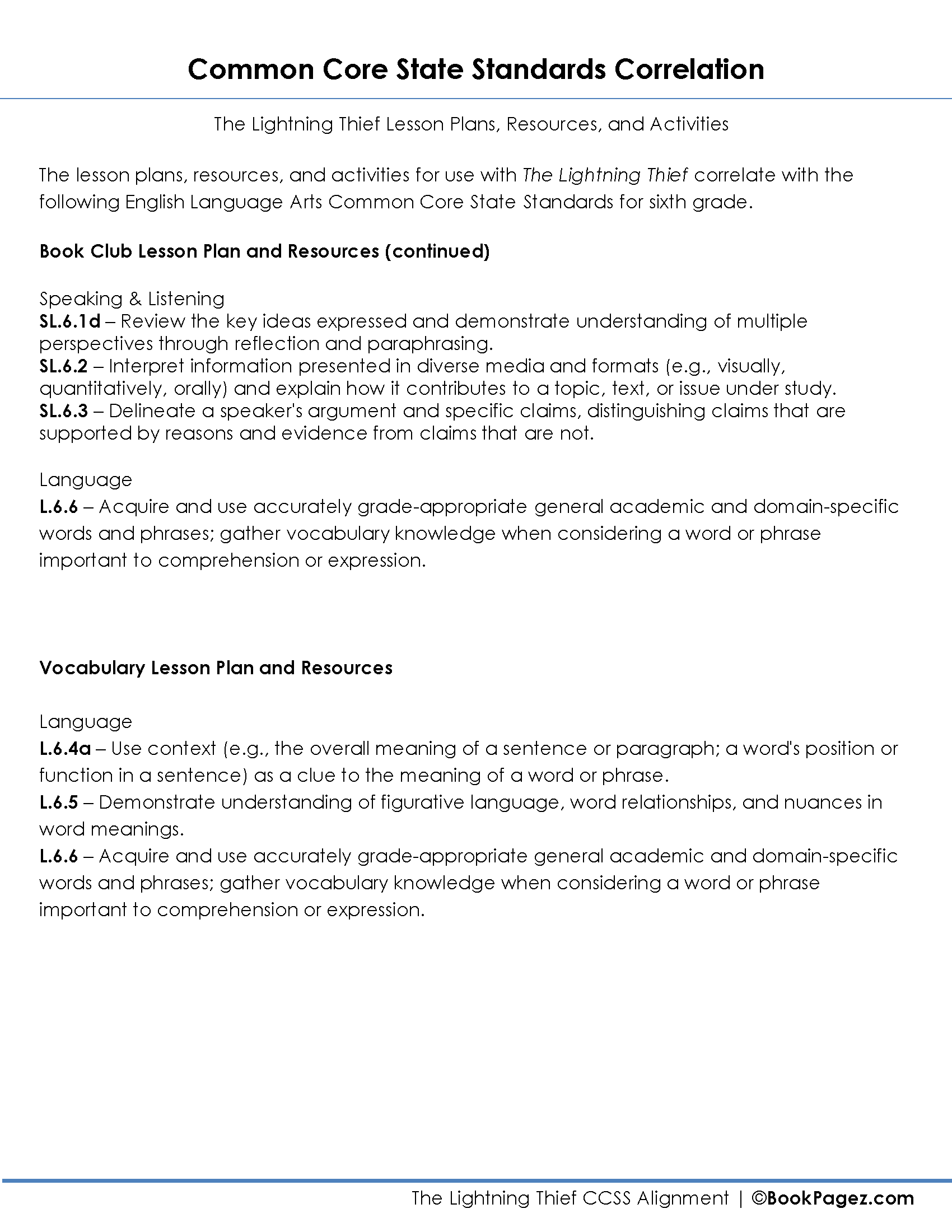
All of the Book Club Lesson Plans include Common Core State Standard and Texas Essential Knowledge and Skills alignment. The standards listed are based on the Guided Reading Level of the book pairing.
So, for example, if the book has been identified as a Guided Reading level R, the book is most appropriate for students reading at a fourth grade level. Therefore, we have aligned the Book Club and included resources to the standards for fourth grade.
So, for example, if the book has been identified as a Guided Reading level R, the book is most appropriate for students reading at a fourth grade level. Therefore, we have aligned the Book Club and included resources to the standards for fourth grade.
A Note About Differentiation
In addition to pairing the Book Club Resource Sets with children’s books, we’ve also leveled each set of resources according to the Fountas and Pinnell Guided Reading Level for each book.
Choosing resources that have been specifically written to support readers at their individual reading levels not only allows you to deliver super-targeted reading instruction but also has been proven to make a difference in reading progress. You’ll find the Guided Reading Level listed in the upper right-hand corner of the Book Club Lesson Plans.
Choosing resources that have been specifically written to support readers at their individual reading levels not only allows you to deliver super-targeted reading instruction but also has been proven to make a difference in reading progress. You’ll find the Guided Reading Level listed in the upper right-hand corner of the Book Club Lesson Plans.


